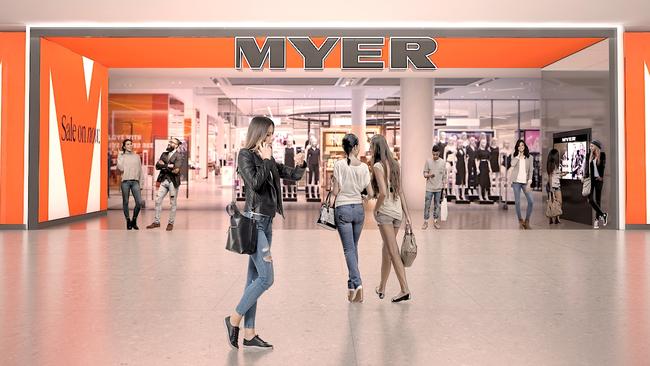
How is she going to do it? Data and loyalty will lead her reinvention. A bit of luck and investment will help her along.
It’s been almost a decade since Myer has fronted investors with any plan beyond short-term financial fixes such as cost cutting and store closures. Wirth has laid out a detailed strategy to build the business for the long term from online to sourcing while delivering financial returns. Myer now has purpose again.
Wirth has a daunting task ahead. Myer has plenty going on – including a complex integration of Solomon Lew’s portfolio of mature retailing brands in the form of Just Jeans, Portmans and Jacqui E. At the same time, Myer has been starved of investment. It’s spent the best part of two decades locked in survival mode or watching private equity walk off with the spoils of property sales.

That’s why Myer has been managed for slow decline. Its warehouses are operating with stock management systems installed in the 1980s, and flagship stores in Sydney and Melbourne CBD and across the suburban malls are long overdue for a refresh. In fact, it’s a miracle its online business has been able to thrive under the bureaucracy of a full-service department store.
Wirth has promised a major store refresh starting from next year, and the program will be built around the notion that the flagship stores and big earners will get the lion’s share of capital.
The former Qantas loyalty program boss was named executive chair of Myer early last year and hasn’t stood still. She’s taken management lessons from aviation that, even in tough times, it pays to look over the horizon.
She’s batted away criticism of her lack of retailing experience. With the support of Myer’s biggest shareholder and one-time loudest critic, Solomon Lew, Wirth has taken out Lew’s apparel brands this year and brought brands such as Sass & Bide, that were once earmarked for sale, back into the fold.
Wirth has clamped down on the concessions game that turns department stores such as Myer into little more than a retailing landlord. She also clearly outlined the five core retail markets where Myer wants to play: Womenswear, menswear, beauty, kids and homewares.
This has comes while navigating a brutally tough retail market awash with peak interest rates and confidence-sapping inflation.
Wirth was gifted a stronger financial position following the brief spell of former chief John King. His efforts were on a much-needed fix of the balance sheet, and for the first time in years Myer found itself in a net cash position as the new CEO took charge.
Wirth’s view is Myer’s biggest defence is also its biggest lever to attack. Now two decades old and with 4.6 million active members, the Myer One loyalty program is one of the richest sources of Australian retailing data.
This is an opportunity to tap AI in a big way. Already Myer has more than 50 proprietary AI models working in the background on personalisation and engagement of Myer One customers.

Spending of Myer One members is 2.8 times that of the non-members and the bulk of new membership is coming from the sought-after under 35s. To shift the dial even slightly on engagement will translate to a large revenue gain.
Already, online is generating more than $800m in annual sales and represents the fast growth of the business.
Wirth wants a seamless, personal experience for shoppers in store or online. There’s also options for suppliers to tap into this. Within coming months Myer One will be expanded to customers of Just Jeans, Jacqui E and the remaining Apparel Brands. Also this year will be a revamp of the scheme, with more generous thresholds to switch on less active customers.
The biggest source of competition is increasingly from online retailers such as Amazon and Temu.
“Rivals can’t build similar programs overnight. It takes time to scale, time to build data, time to build analytics, time to embed in the business, and time to build partnerships,” Wirth says.
It was a controversial decision to push ahead with the $800m buyout of Lew’s Apparel Brands, but Wirth has maintained the deal was all about making a more financially resilient Myer with a bigger balance sheet. The combined group now has more than $4bn in annual sales and is set to generate $320m in free cashflow for greater reinvestment.

The profit margin across Apparel Brands runs at more than double Myer’s skinny 5 per cent. And any incremental 1 per cent uplift in Myer’s margins from shared resources and synergies translates into a $33m lift in group earnings.
Likewise, any lowering in the cost of doing business also pumps up the earnings line. Sourcing has long been a problem and this is another area where Wirth is determined to improve, leveraging the best practice from the Apparel Brands team.
The perennial challenge for Myer has been about execution. The ramp-up of its new smart warehouse outside Melbourne has been problematic and costly. There’s also a big question about the level of capital needed to bring the stores up to the standard that Wirth hopes for.
Renovations are costly, time consuming and come with plenty of execution risk.
Still, Myer now has a long-term plan to become a serious investment proposition by the end of the decade. This gives it a fighting chance.
NBN’s big bond
Canberra-backed NBN Co has been rushed by offshore investors for its first ever sustainability bond issue (a combination of green and social projects), raising €700m ($1.2bn) in European debt markets.
The move also marks the first Australian name to raise funds under a sustainability bond program, paving the way for others to tap the market.
The monster raising follows a roadshow led by group treasurer Fiona Trigona in Europe pitching to prospective fund managers, including pension funds. An investor briefing was held this month in Frankfurt and in London where more than 60 asset managers ran through NBN Co’s numbers.

The issue, which settles on Thursday, was four times oversubscribed and about 90 investors took part. In an indication that Europe’s debt markets are increasingly seen as a safe haven, the bond also had high demand from Asian investors.
Funds from the raising will be allocated across a combination of energy efficiency projects and social projects, including digital accessibility.
NBN is becoming a big international investor, as it refinances the cost of its massive build project. It has more than $21bn on issue in global debt markets with about a third of this issued under the green bond program.
Some 15 per cent of the debt is held by central banks and sovereign wealth funds, with Japanese life funds becoming an increase source of demand.
eric.johnston@news.com.au




Olivia Wirth has delivered a new-look Myer with the ambition to reclaim its pre-eminent place in Australian retailing and no longer being held hostage to the economic cycle.